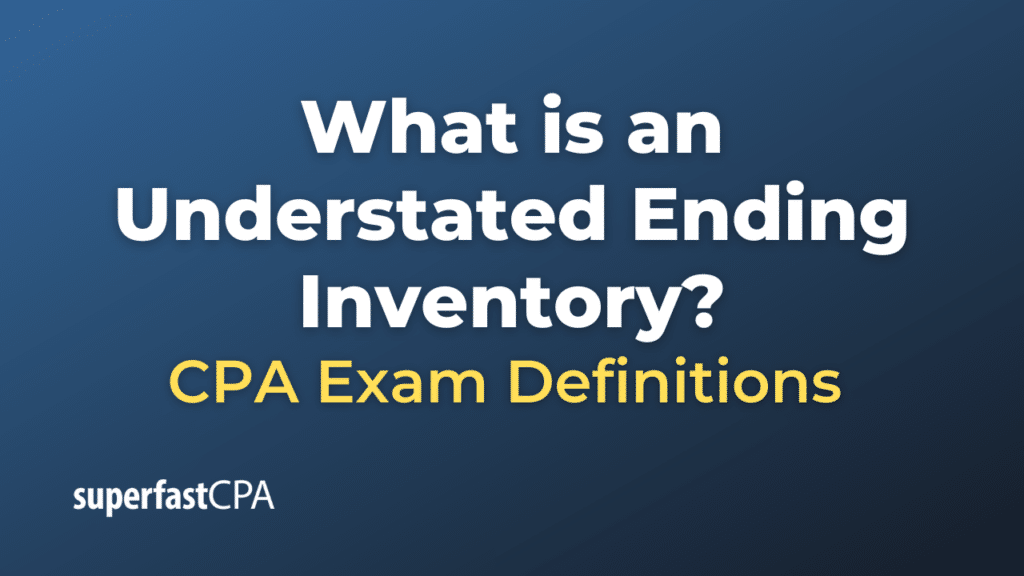Understated Ending Inventory
An “understated ending inventory” in accounting refers to a situation where the value of the ending inventory is reported to be less than its actual value. This understatement can arise from various reasons such as errors in counting, valuation mistakes, or even fraudulent activities aimed at manipulating financial statements.
Impact of Understating Ending Inventory
The understatement of ending inventory can have several consequences on the financial statements:
- Lower Assets: Since inventory is an asset, understating it will result in a lower total asset value on the balance sheet.
- Higher Cost of Goods Sold (COGS) : Inventory levels directly affect the COGS. If ending inventory is understated, the COGS will appear higher than it actually is because COGS = Beginning Inventory + Purchases − Ending Inventory.
- Lower Gross Profit: A higher COGS leads to a lower gross profit, which is calculated as Gross Profit = Revenue − COGS.
- Lower Net Income : Lower gross profit will likely lead to lower net income, affecting the profitability ratios and earnings per share (EPS).
- Tax Implications : Lower net income may also result in lower taxable income, potentially reducing the taxes payable for the period.
- Misleading Financial Statements: Understated ending inventory can mislead stakeholders about the financial health and profitability of the company.
- Audit Concerns: If the understatement is significant or recurrent, it might raise concerns during an audit and could even be considered fraudulent if done intentionally.
Example of an Understated Ending Inventory
Let’s walk through a numerical example to illustrate the impact of an understated ending inventory on a company’s financial statements.
Assumptions
- Beginning Inventory: $20,000
- Purchases: $40,000
- Reported Ending Inventory: $10,000 (Understated)
- Actual Ending Inventory: $15,000
- Sales Revenue: $80,000
Calculating COGS and Gross Profit
Incorrect Calculation (with Understated Ending Inventory)
- COGS = Beginning Inventory + Purchases – Reported Ending Inventory
- COGS = $20,000 + $40,000 – $10,000 = $50,000
- Gross Profit = Sales Revenue – COGS
- Gross Profit = $80,000 – $50,000 = $30,000
Correct Calculation (with Actual Ending Inventory)
- COGS = Beginning Inventory + Purchases – Actual Ending Inventory
- COGS = $20,000 + $40,000 – $15,000 = $45,000
- Gross Profit = Sales Revenue – COGS
- Gross Profit = $80,000 – $45,000 = $35,000
Impacts
- Lower Assets: The understated ending inventory would result in total assets being $5,000 less than they actually are.
- Higher COGS: The COGS appear to be $50,000 instead of the correct $45,000—a $5,000 difference.
- Lower Gross Profit: Because of the higher COGS, the gross profit is reported as $30,000 instead of the correct $35,000—a $5,000 difference.
- Lower Net Income: The lower gross profit would also lead to a lower net income, assuming all other expenses remain constant.
- Tax Implications: The lower net income might lead to a lower tax liability, which could have legal ramifications if the understatement was intentional.
- Misleading Financial Statements: Stakeholders like investors and creditors may get a distorted view of the company’s profitability and financial health.
Corrective Action
If the company discovers the mistake, it should issue correcting entries and potentially restate prior-period financial statements, depending on the significance of the error. This would involve adjusting the value of the ending inventory to the correct amount and making corresponding adjustments to COGS, gross profit, net income, and tax liabilities.
By correcting the understated ending inventory, the company would provide a more accurate and reliable financial picture to its stakeholders.













